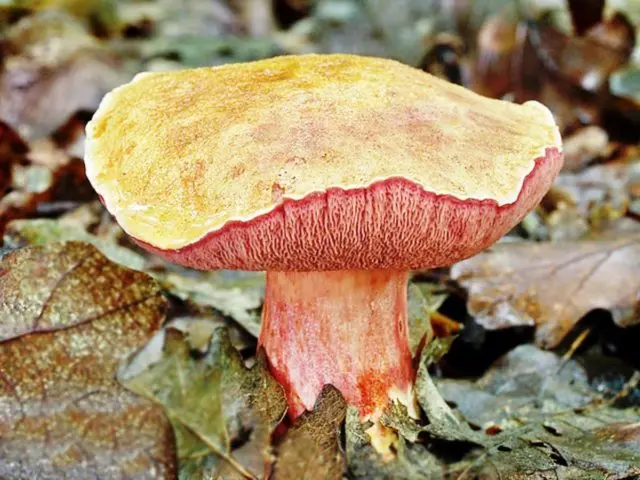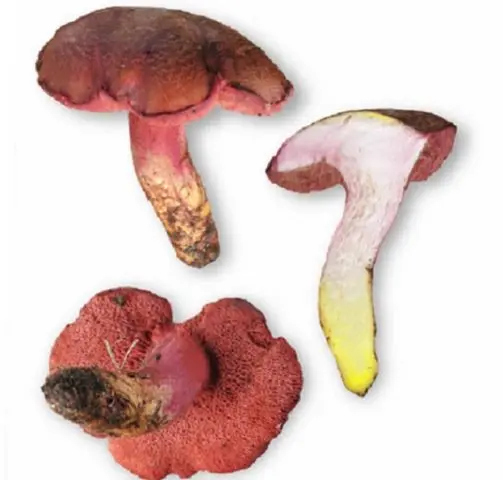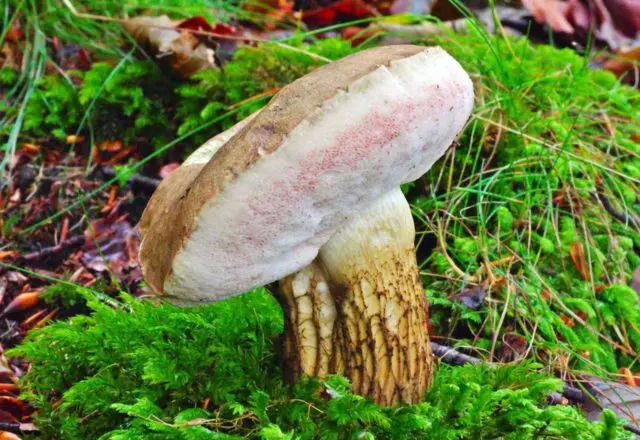Contents
Ruby butterdish (Suillus rubinus) is an edible fungus from the Boletaceae family. The species differs from other representatives of the genus in the characteristic color of the hymenophore and legs, which have a juicy lingonberry-pink hue.
What does a ruby oiler look like?
Ruby butterdish has a number of other names given to it at different times by botanists from Germany and other European countries, where it is distributed:
- ruby mushroom;
- ruby pepper mushroom;
- flywheel ruby;
- rubinoboletus;
- ruby chalciporus.
Scientists agreed on one thing – the ruby color most accurately conveys the color of the lower part of the oiler’s cap and the surface of its legs.
Cap Description
Suillus rubinus is a small mushroom with a cap diameter of 4-8 cm. Young specimens have a hemispherical or round cap, but with age it opens, turning into a flat, cushion-shaped. At the same time, the sharp wavy edges of the cap turn inside out and bend upwards. The peel covering the upper part of the cap is dry, feels like suede to the touch, and cannot be removed with a knife. In dry weather, cracks may appear on it; in rainy weather, it is covered with a thin layer of mucus. Hat color can be:
- brick;
- yellowish brown;
- carmine red;
- brownish yellow.
The flesh of the cap has several shades: under the skin it is bright yellow, in the middle part it is yellowish, next to the tubular layer it is pink. When cutting the mushroom in the upper part of the leg, the color of the pulp does not change.
The lower part of the cap (hymenophore) is a tubular structure with large pores, painted in a rich red-pink color. When pressed, the color of the tubes does not change. Reproduction of the ruby oiler is carried out by means of microscopic rounded or broadly elliptical ocher-colored spores, which are formed in a brownish spore powder.

Description of the leg
The ruby butter dish has a strong low leg, shaped like a mace or a cylinder, tapering towards the base. Its diameter usually does not exceed 3 cm, the average height is 3-6 cm. Often there are specimens with a curved leg. The surface is smooth, in rare cases pubescent, painted in a thin, barely perceptible mesh pattern of carmine-pink color, the bottom is ocher-yellow. With a longitudinal section of the fungus, you can see that the flesh of the leg has a heterogeneous color. At the base it is rich yellow, the rest is pinkish.

The ruby butterdish is rare in Our Country, it is considered a new species, its habitat is still subject to study and monitoring. Despite the lack of data, the ruby butterdish is listed in the Red Book of the Federation.
Is ruby butterdish edible or not?
Rubinoboletus is an edible mushroom with good taste. According to nutritional value, it belongs to the 2nd group, along with edible champignon, oak, boletus and other types of oil. Its pulp does not have a pronounced smell and taste, some specimens have a barely noticeable bitterness. The chemical composition of the ruby oiler includes:
- vitamin B2 (riboflavin);
- vitamin bxnumx;
- carbohydrates;
- lecithin;
- amino acids;
- fatty acid;
- essential oils.
100 g of the product contains only 19,2 kcal, the use of oil helps to remove uric acid from the body and lower cholesterol levels. However, biologists strongly recommend that you refrain from collecting these mushrooms, as the species is on the verge of extinction.
Where and how does the ruby butterdish grow?
Rubinoboletus is common in some European countries, it is extremely rare in the Federation, mainly in the Far East and Transcaucasia. The only confirmed place of growth of this fungus in Our Country is a forest belt in the vicinity of the village. Oatmeal in the Amur region.
The fungus prefers an oak or mixed forest with a predominance of birch, beech, linden, chestnut, hawthorn, and holly. In rare cases, it grows in a pine forest with a small admixture of hardwoods. The oiler of this species can be found in the undergrowth with a dense forb cover, where there is a large amount of cereals. The soil likes fertile, most often found on silty loams, on floodplains and in places where livestock regularly grazes.
Ruby boletus – mushrooms growing singly or in 2-3 pieces. Cases of the development of mycelium Suillus rubinus on well-decomposed oak wood have been recorded. Rubinoboletus does not bear fruit annually, the best conditions for active growth are warm and rainy summers and early autumn.
Inexperienced mushroom pickers may confuse a ruby butter dish with a gall mushroom. The species are similar in the structure of the fruiting body, but the twin does not have the characteristic pinkish color of the stem, and the tubular layer becomes red-brown when pressed.

How ruby butter is prepared
The mushroom is eaten after heat treatment. Butterfish are good fried, boiled, stewed, salted and pickled. They can also be dried.
Conclusion
The ruby butter dish is an object of study and close attention of mycologists. When it is in the forest, it is better to leave the mushroom untouched so that the species does not disappear forever. In places where Suillus rubinus grows, you can easily find other species that are not inferior to it in nutritional value and taste.









